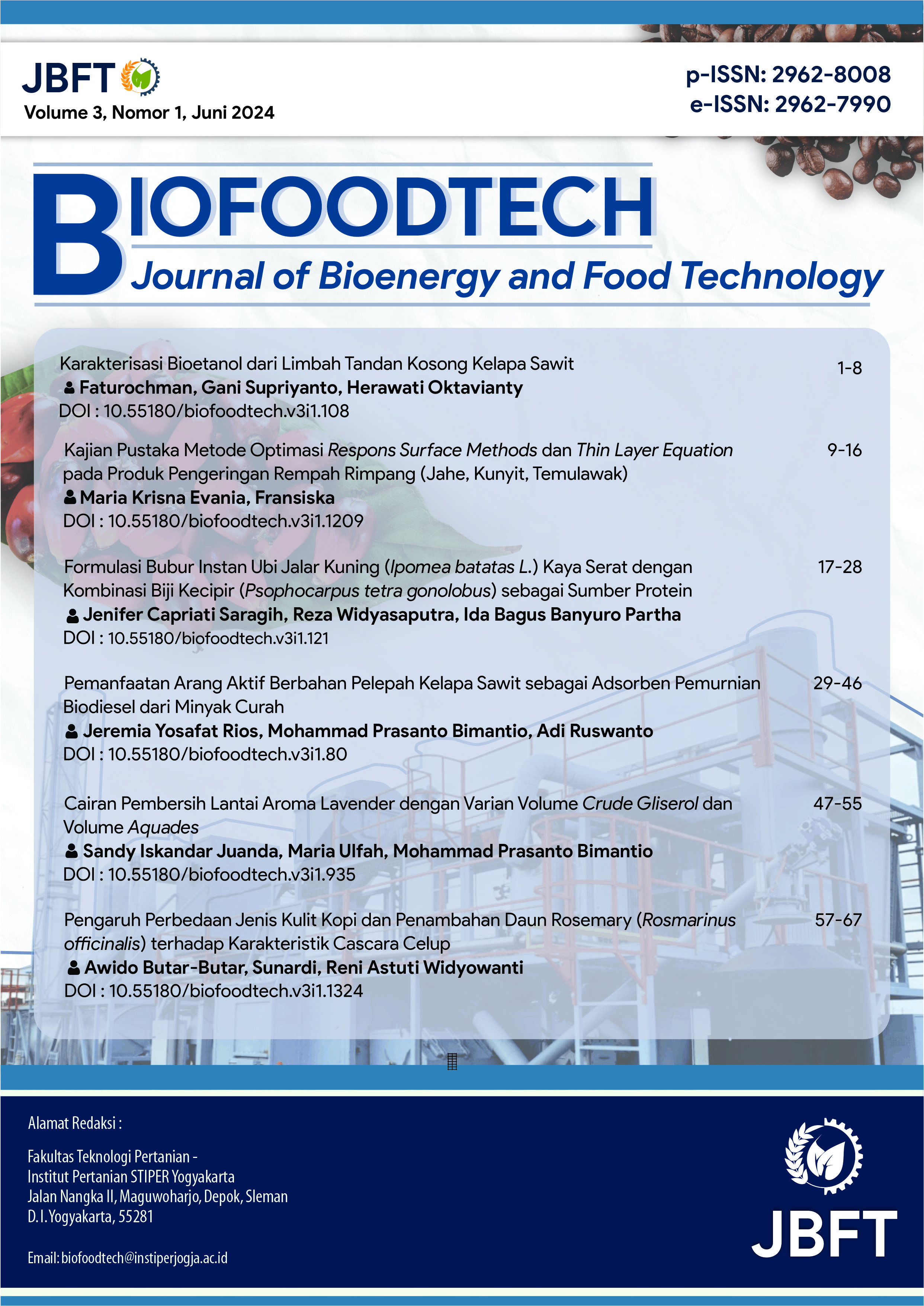Cairan Pembersih Lantai Aroma Lavender dengan Varian Volume Crude Gliserol dan Volume Aquades
DOI:
https://doi.org/10.55180/biofoodtech.v3i1.935Kata Kunci:
Crude Gliserol, Aquades, floor cleanerAbstrak
Floor cleaner liquid is made by formulating several ingredients, including arpus which is used as a disinfectant, texapon as a surfactant and hydroxy ethyl cellulose (HEC) as a thickener. Crude glycerol needs to be added to the floor cleaner formula to soften the texapon and increase the solubility of HEC. This research aimed to determine the effect of the amount of crude glycerol and distilled water on the chemical, physical and organoleptic properties of the floor cleaner fluid produced and to obtain the best floor cleaner. This research was designed using a Randomized Complete Block Design (RCBD) with two variable factors. The first factor is the volume of crude glycerol (A) which consists of 3 levels, including: A1 (50 mL), A2 (70 mL), A3 (100 mL). The second factor is the volume of distilled water (B) which consists of 3 levels, including: B1 (300 mL), B2 (400 mL), B3 (500 mL). The results of the research showed that the volume of crude glycerol had an effect on the pH of the floor cleaner, but had no effect on viscosity, density, preferred aroma, color and level of cleaning ability. The volume of distilled water has no effect on the pH, viscosity, density, preferred aroma, color and level of cleaning ability of the floor cleaner. Based on pH, the best floor cleaner was obtained in treatment A1B1 with an average favorability score of 4.17 (like), pH 7.16, viscosity 129.5 cP and density 1.02 g/cm3.
Referensi
Akhmad, Fandi (2017). Formulasi Cairan Pembersih Lantai dari Najis Mughalladzah dengan Variasi Konsentrasi Kaolin-Bentonit dan Variasi Konsentrasi Natrium Metasilikat (Bachelor's thesis, FKIK UIN JAKARTA).
Badan Standardisasi Nasional. (1995). SNI 01-3951-1995 Susu Pasteurisasi (01-3951–1995).
Badan Standardisasi Nasional. (2019). SNI 1842:2019 Pembersih Lantai (1842:2019).
Damarjati, D. (2016, Februari 7). Pemanfaatan Limbah minyak jelantah menjadi Sabun pembersih lantai Sebagai upaya peningkatan home industry – KKN UNIVERSITAS DIPONEGORO. http://kkn.undip.ac.id/?p=46619
Desfitri, Erda R., Desmiarti, R., Verdana, S. Y., & Amanda, A. (2022). Pembuatan cairan pembersih lantai dengan memanfaatkan minyak atsiri dan hidrosolnya. REACTOR: Journal of Research on Chemistry and Engineering, 3(1), 28-35.
Fauziah, S. H., & Agamuthu, P. (2010). Landfills in Malaysia: Past, present and future. Universiti Malaya
Gaskell, J. C. (2015). The role of markets, technology, and policy in generating palm-oil demand in Indonesia. Bulletin of Indonesian Economic Studies, 51(1), 29-45.
Hambali, E. (2006). Jarak pagar: tanaman penghasil biodiesel. Niaga Swadaya.
Ketaren, S. (1986). Pengantar Teknologi Minyak dan Lemak Pangan. UI Press.
Pagliaro, M., & Rossi, M. (2008). Sustainability of bioglycerol. The Future of Glycerol: New Usages for a Versatile Raw Material, 109-123.
Pramono, Ajar. (2003). Membuat Cairan Pembersih Lantai. Puspa Swara. Jakarta
Putro, S. S., & Utami, W. P. (2011). Pembuatan Sabun Cair Dari Minyak Goreng Bekas. Fakultas Teknik Universitas Sebelas Maret Surakarta.
Ramadhanty, Aureadzani I. (2017) Kualitas Formula Cairan Pembersih Lantai Alami dari Campuran Saponin Daun Akasia, Hidrosol Sereh Wangi, dan Gondorukem. Institut Pertanian Bogor
SNI 01-3741-2002.(2002). Minyak Goreng. Badan Standardisasi Nasional
Sukmawati, S., & Lestari, P. P. (2021). OPTIMASI TEMPERATUR DAN KONSENTRASI NaOH PADA PEMBUATAN KARBOL DARI MINYAK JELANTAH. CHEDS: Journal of Chemistry, Education, and Science, 5(2), 74-79.
Ulfah, M., Raharjo, S., Hastuti, P., & Darmadji, P. (2017). Adsorption of β-Carotene in Isopropyl Alcohol with Decolorized Activated Carbon as Model for β-Carotene Adsorption in Crude Palm Oil. Indonesian Journal of Chemistry, 17(1), Article 1. https://doi.org/10.22146/ijc.23637
Ulfah, M., Tamanampo, C,N., & Sunardi, 2023. Kemampuan Karbon Aktif Cangkang Sawit untuk Pemurnian Minyak Jelantah Dibandingkan Karbon Aktif Standard, Seminar Nasional INSTIPER, Yogyakarta.
Zamroni, M. (2020, Maret 28). Mengenal Reduce pada Prinsip 3R atau Reduce, Reuse, Recycle Olah Sampah. Tunas Hijau ID. https://tunashijau.id/2020/03/mengenal-reduce-pada-prinsip-3r-atau-reduce-reuse-recycle-olah-sampah/
Unduhan
Diterbitkan
Cara Mengutip
Terbitan
Bagian
Citation Check
Lisensi
Hak Cipta (c) 2024 BIOFOODTECH : Journal of Bioenergy and Food Technology

Artikel ini berlisensiCreative Commons Attribution-NonCommercial-ShareAlike 4.0 International License.











